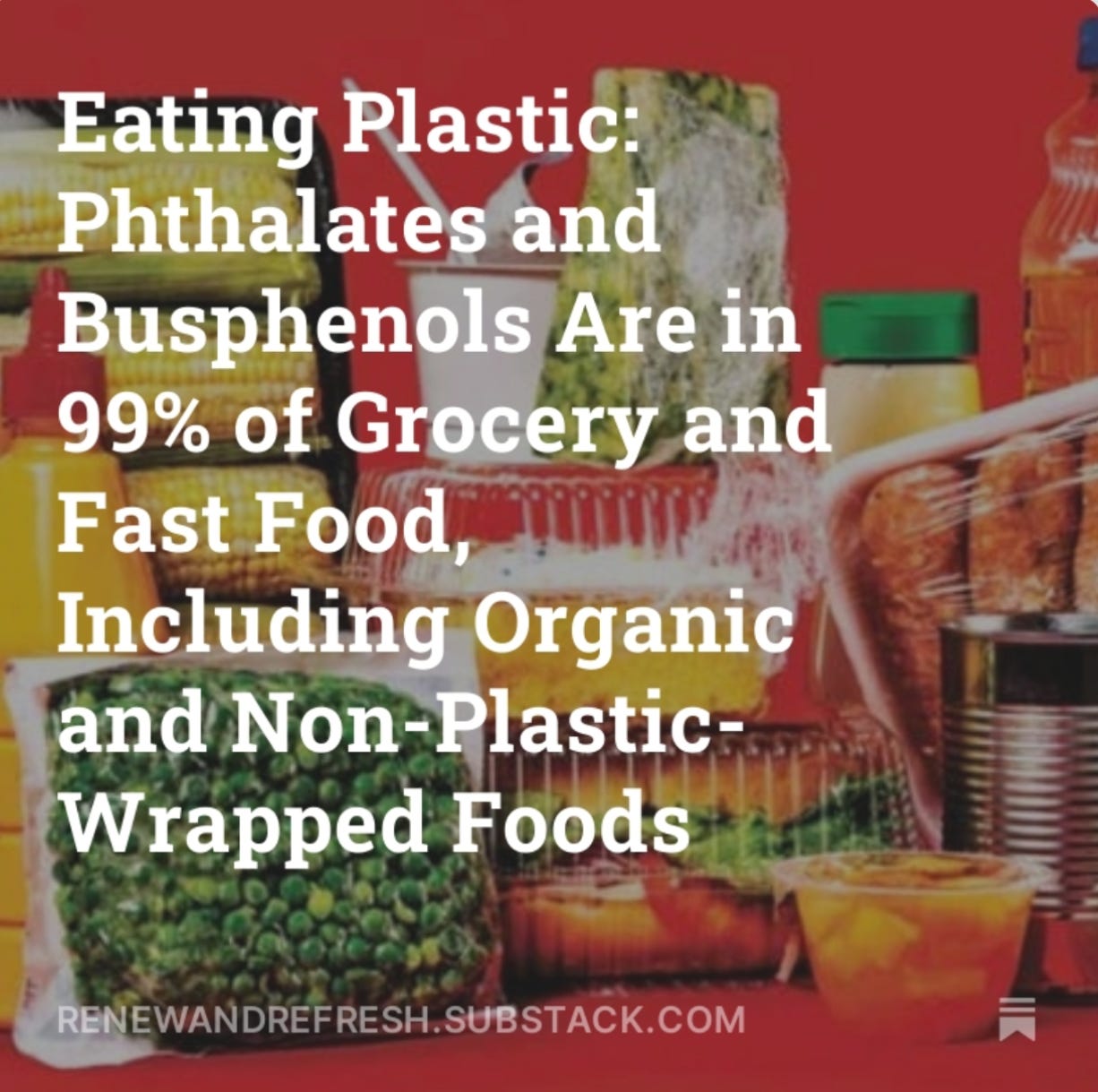Eating Plastic: Phthalates and Bisphenols Are in 99% of Supermarket and Fast Food, Including "Certified Organic" and Non-Plastic-Wrapped Foods
An Investigation by Consumer Reports
After testing foods for plasticizers only a few times in the last 25 years, Consumer Reports investigated again.
According to their January 4, 2024 investigation, unacceptably high levels of the plasticizers called phthalates and bisphenols are in our grocery and fast foods.
Plasticizers
A plasticizer is a chemical used to make plastics more flexible and durable. Todays plasticizers show up inside almost all of us. Even low levels are implicated in a long list of health concerns.
Phthalates and biphenols are compounds implicated in diabetes and hormone imbalance. CR found high levels are "widespread" among grocery and fast foods.
High plasticizer levels were found even if foods were “certified organic” or wrapped in a non-plastic wrap.
“Researchers found that 99% of the supermarket and fast foods they tested contained phthalates, also known as plasticizers, which are chemicals that are added to plastics to make them more flexible.
In addition, 79% of the food samples contained bisphenol A (BPA), an industrial chemical used in plastic manufacturing, and other bisphenols. Both chemicals have been found in studies to be hazardous to health.”
“We found them in almost every food we tested, often at high levels. The levels did not depend on packaging type, and no one particular type of food—say, dairy products or prepared meals—was more likely than another to have them.”
Health Risks
Phthalates. According to a 2008 report by the National Research Council Research, phthalates are linked to causing reproductive disorders and genital abnormalities.
Bisphenol A (BPA). According to a Mayo Clinic study, BPA is linked to causing high blood pressure, Type 2 diabetes, and heart disease.
Route of Plastics Contamination
Consumer Reports found that plastics don't leach in from just cellophane wrapping. They get into foods by these routes:
Tubing
Conveyor belts
Gloves used during processing
Contaminated water
Contaminated soil
There are only a few laws regulating phthalate use in foods. Just last year, the FDA rejected a petition that to ban phthalates in food packaging and processing. Some experts agree that BPA regulations are outdated and ineffective.
Consumer Reports lead scientist for the food testing Tunde Akinleye, stated in the report:
"Many of these thresholds do not reflect the most current scientific knowledge, and may not protect against all the potential health effects… We don't feel comfortable saying these levels are okay. They're not… The more we learn about these chemicals, including how widespread they are, the more it seems clear that they can harm us even at very low levels.”
Testing 85 Foods for 10 Phthalates and 3 Bisphenols
Consumer Reports tested two or three samples of these foods that were contained in different types of packaging, such as tin cans, pouches, and aluminum foil:
Prepared meals
Fruits
Vegetables
Milk and other dairy products
Baby food
Meat
Seafood
Phthalate Levels in Supermarket Foods
Annie's Organic Cheesy Ravioli: contained the highest phthalate level, 53,579 per nanogram
Del Monte Sliced Peaches: 24,928 phthalates per nanogram
Chicken of the Sea Pink Salmon: 24,321 phthalates per nanogram.
Fairlife Core Power high-protein chocolate milkshakes
Yoplait Original French vanilla low-fat yogurt
Polar Seltzer Raspberry Lime: This was the only product that tested negative.
Phthalate Levels in Fast Foods
In comparison, fast foods had much lower phthalate levels:
McDonald's Quarter Pounder With Cheese: 9,956 phthalates per nanogram
Little Caesars Classic Cheese Pizza (in a cardboard box): 5,703 phthalates per nanogram.
Wendy's Crispy Chicken Nuggets: 33,980 phthalates per nanogram.
Wendy’s crispy Chipotle chicken burrito
Burger King Whopper with cheese
Organic products were just as problematic: In fact, the highest phthalate levels we found were in a can of Annie’s Organic cheesy ravioli.
Recommendations
Grow your own food, and/or buy from a Farmer's Market. And don't be offended by someone's hands on your food - it could be better for you than a plastic glove.
WHAT I REALLY THINK
I started thinking about plastics on our food when at a friend's for Thanksgiving. Thankfully, the host let me help her with the dinner but
Keep reading with a 7-day free trial
Subscribe to Renew And Refresh to keep reading this post and get 7 days of free access to the full post archives.





